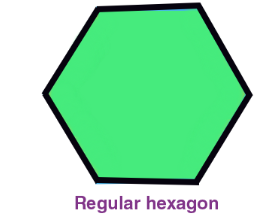Geometry, with its multitude of shapes and structures, offers an exciting journey into the world of polygons. Among these, the hexagon stands as a remarkable six-sided figure with intriguing properties and diverse applications. The term “hexagon” is derived from the Greek words “hex,” meaning “six,” and “gonia,” meaning “angle.” In this comprehensive guide, we’ll delve into the world of hexagons, understanding their definition, types, properties, real-world examples, and answering frequently asked questions.
Table of Contents:
- What is a Hexagon?
- Types of Hexagons
- Properties of Hexagons
- Area of Hexagon
- Perimeter of a Hexagon
- Hexagon FAQs
- Exploring Hexagons: A Fun Tutorial
Table of Contents
What is a Hexagon?
A hexagon is a six-sided polygon, a two-dimensional geometric shape with six straight sides and six angles. Hexagons come in various forms, including regular hexagons, where all sides and angles are equal, and irregular hexagons, where side lengths and angles may vary.
In a regular hexagon, each interior angle measures 120 degrees, and all sides are of equal length. The sum of the interior angles of a hexagon is always 720 degrees. Hexagons are known for their unique symmetry and are commonly found in nature, in human-made structures, and in various design and engineering applications.

Types of Hexagons
Hexagons come in various forms:
- Regular Hexagon: All six sides and angles are equal in length and measure, making it a symmetrical polygon.
- Irregular Hexagon: Side lengths and angles may vary, lacking the symmetry of a regular hexagon.
- Convex Hexagon: All interior angles are less than 180 degrees, giving the shape an outward bulge.
- Concave Hexagon: At least one interior angle is greater than 180 degrees, resulting in a dent or “cave” within the shape.
Properties of Hexagons
Hexagons exhibit distinct properties:
- Six Sides: Every hexagon has six straight sides.
- Six Angles: Hexagons possess six interior angles.
- Sum of Angles: The sum of the interior angles in a hexagon is always 720 degrees.
- Diagonals: A hexagon has nine diagonals connecting non-adjacent vertices.
Perimeter of a Hexagon
The perimeter of a hexagon, which is the total length of its six sides, depends on the lengths of those sides. If you know the lengths of all six sides, you can find the perimeter by simply adding them together:

Perimeter= Side1+ Side2 + Side3+ Side4+ Side5+ Side6
Where “Side_1,” “Side_2,” and so on represent the lengths of the six sides of the hexagon.
Calculating the perimeter of a regular hexagon (where all sides are equal) is simplified because you can multiply the length of one side by 6:

Perimeter of a Regular Hexagon= 6 × Side
For an irregular hexagon (where side lengths may vary), you need to sum the lengths of all six sides to find the perimeter.
Area of Hexagon
The area of a hexagon depends on its type (regular or irregular) and the available information. To calculate the area of a hexagon, you can use the following formulas:
1. Area of a Regular Hexagon: If you have a regular hexagon (all sides and angles are equal) and you know the side length (s), you can use this formula:
Area = 3√3/2 × s2
Where:
- is the side length of the regular hexagon.
2. Area of an Irregular Hexagon: If you have an irregular hexagon where the side lengths and angles may vary, calculating the area can be more complex. You may need to divide the irregular hexagon into triangles or other shapes and calculate their individual areas, then sum them to find the total area.
These formulas provide a way to find the area of hexagons, depending on the given information and the type of hexagon (regular or irregular).
Solved Examples on Hexagon
Problem 1 – Area of a Regular Hexagon: Find the area of a regular hexagon with a side length of 10 cm.
Solution: Using the formula for the area of a regular hexagon:
Area = 3√3/2 × s2
Substitute the side length (s = 10 cm) into the formula:
Area = 3√3/2 × 102
Calculate the area:
Area≈259.81cm2
Problem 2 – Calculate the perimeter of an irregular hexagon with side lengths of 7 cm, 8 cm, 6 cm, 9 cm, 5 cm, and 10 cm.
Solution: To find the perimeter of an irregular hexagon, sum the lengths of all six sides:
Perimeter= 7cm+8cm+6cm+9cm+5cm+10cm=45cm
The perimeter of the irregular hexagon is 45 centimeters.
Problem 3 – Calculate the sum of the interior angles of a hexagon.
Solution: The sum of interior angles in a hexagon can be found using the formula:
Sum of Interior Angles=180∘×(n−2)
For a hexagon (6 sides):
Sum of Interior Angles=180∘×(6−2)=180∘×4=720∘
So, the sum of the interior angles of a hexagon is 720 degrees.